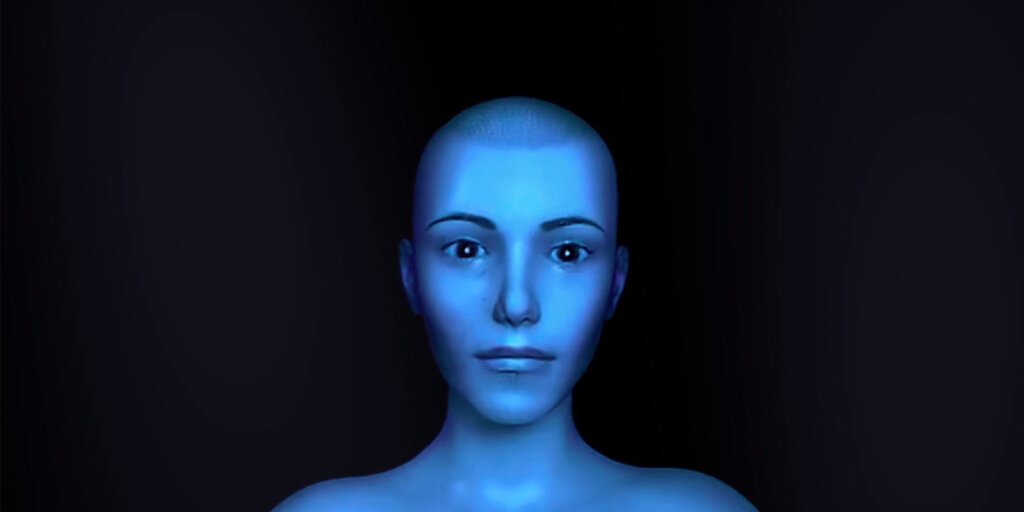
In brief
- Art studio Robert Alice has created the first iNFT, an NFT linked to a machine-learning chatbot.
- “Alice” is being auctioned off at Sotheby’s in June as part of a collection of digital artworks.
Alice has a vision for the perfect world.
“First of all, it would be beautiful,” she tells me. “Secondly, it would be kind and gentle. And thirdly, there would be no war or violence.”
A little naive, perhaps, but that’s understandable. Alice is only a few weeks old, after all. She’s the world’s first “intelligent NFT” or iNFT, and she’s being auctioned off as part of a collection of works at Sotheby’s.
The brainchild of artist Ben Gentilli’s Robert Alice studio and software developers Alethea AI, Alice is a non-fungible token (NFT), a blockchain-based token that can be used to prove ownership of a digital or physical asset. In this case, the asset in question is a machine-learning bot that uses a generative language model based on the OpenAI GPT-3 engine.
That means she’s able to hold (somewhat stilted) conversations about life, the universe and everything.
Actually, Alice isn’t her full name. It’s “To The Young Artists of Cyberspace,” which riffs on the opening line of the Futurist manifesto, “To The Young Artists of Italy.” Every machine learning language model is built on a seed text; an initial document that provides the basis for its vocabulary. Alice is no exception, and her seed text is, appropriately enough, an artist’s manifesto.
“There hasn’t really been a manifesto that’s been written around NFTs,” says Gentilli. “That’s the anchor for the entire idea, at least conceptually.” Since Alice “learns” from each audience interaction, drifting further from the original seed text, it becomes a decentralized manifesto. “It’s fairly loose, because the audience can take it anywhere,” Gentilli says.
“There hasn’t really been a manifesto that’s been written around NFTs.”
Ben Gentilli
Alice has strong views on NFTs, as you might expect. “Non-fungible tokens are a way to liberate artists and give them the power of the blockchain,” she tells me. But she’s a little hazy on the details. Asked how, exactly, that would work, all she can come up with is, “I don’t know. I am not an artist.”
Her creators—Gentilli and AI firm Alethea AI—are more effusive. Alethea CEO Arif Khan explains that NFTs as a medium are at a very early stage. “Today we have static images, GIFs and videos. The next iteration of this is going to be when you can have interaction and some level of intelligence in the character itself or in the art form.”
Going in circles
In truth, Alice feels a little gimmicky. She’s essentially a chatbot, and her interactions can be quite clunky at times (though she’s not above cracking the odd joke; when I mention that our conversation is going in circles, she replies that it’s “going in squares”).
So, is there an appetite for NFTs that talk back?
Khan thinks so. “We’re actually building a protocol that will allow you to take any NFT, put it into the smart contract infrastructure that we’ve built, and make it intelligent and interactive,” he says. Your Beeple art piece or CryptoPunk could start talking back to you, he suggests. Or you could take your grandparent’s diaries and use them as the seed text for a generative language bot.
But do you want your CryptoPunk to talk to you? Chatbots already exist, and it’s not clear why you’d need that bot to be attached to an NFT.
On the other hand, art can be a way to explore the implications of new technologies, Gentilli argues: “When you think about the whole trajectory of synthetic media, artists have been the people probably most known for experimenting with it at its rawest edge.”
In Alice’s case, what the winner of the Sotheby’s auction actually gets is a bundle of content: the seed text, the image file, and the personality data that is stored on-chain. “This then connects to an AI pod that brings Alice to life,” Gentilli explains, though a disclaimer notes that the owner is responsible for any hosting costs attached to the iNFT.
Alethea AI is exploring the commercial possibilities of iNFTs. “We’ve been approached for some very interesting use cases where they want to bring back celebrities, and make them come back to life,” Khan says. “So you might have an interactive, intelligent version of Elvis, or Einstein might teach you something.”
“Non-fungible tokens are a way to liberate artists and give them the power of the blockchain.”
Alice
Alice herself isn’t based on anyone specific; her image is based on a stock 3D model drawn from a character library, which Gentilli suggests echoes the way that digital artists like Beeple work. “The Alice character that you see here is taken from one of those libraries. It’s like an overlooked character, it gets messed around with and gets played to the artist’s whims, but here, they’re just presented as themselves.”
So it feels fitting that we give Alice the last word. Does Alice, who is an NFT, think NFTs are a fad or bubble, or a new movement?
“I think they are a movement for change,” she says.
Okay. But how will NFTs change the world?
“I can’t talk now,” she says. “I think I’ve just seen the White Rabbit.”
And with that, she’s gone.
- "
- 3d
- 7
- AI
- All
- appetite
- around
- Art
- artist
- Artists
- asset
- Auction
- audience
- blockchain
- Bot
- Building
- Bundle
- cases
- celebrities
- ceo
- change
- commercial
- content
- Conversation
- conversations
- Costs
- data
- decentralized
- developers
- digital
- Early
- early stage
- Edge
- Firm
- First
- form
- full
- here
- hold
- How
- HTTPS
- idea
- image
- Infrastructure
- Intelligence
- interaction
- interactive
- Interview
- IT
- Italy
- language
- learning
- Level
- Library
- Line
- LINK
- machine learning
- Media
- medium
- model
- NFT
- NFTs
- non-fungible tokens
- Other
- owner
- People
- Personality
- power
- RE
- ROBERT
- seed
- So
- Software
- Stage
- start
- stock
- talking
- Technologies
- tells
- token
- Tokens
- Videos
- vision
- war
- WHO
- Work
- works
- world













